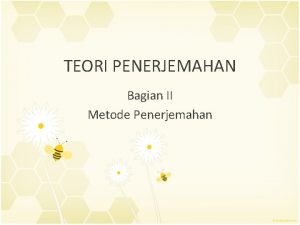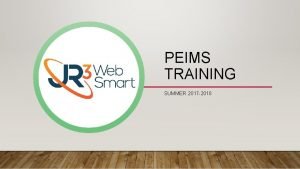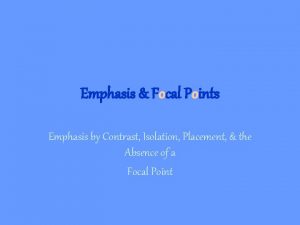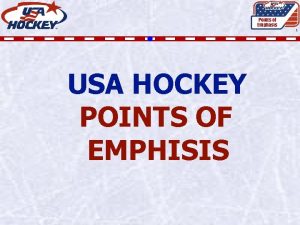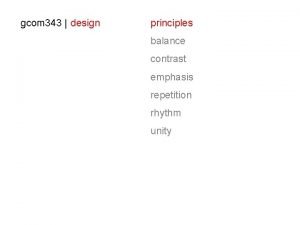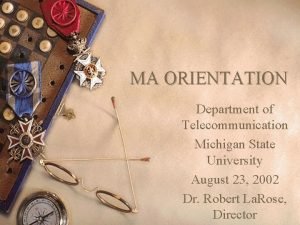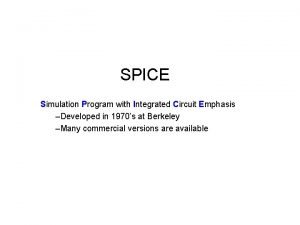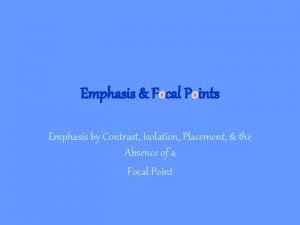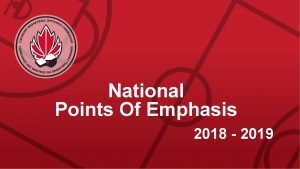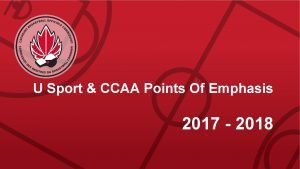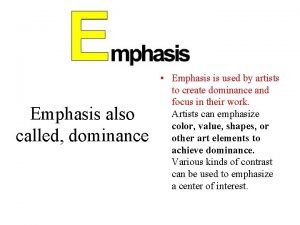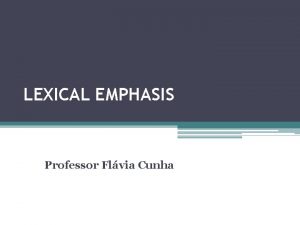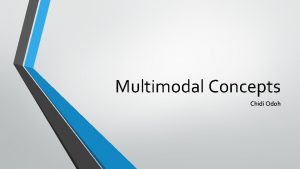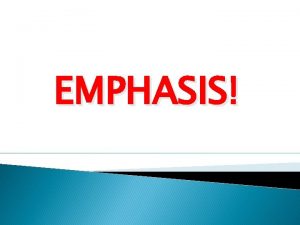Points Of Emphasis 2017 2018 POINTS OF EMPHASIS















- Slides: 15

Points Of Emphasis 2017 - 2018

POINTS OF EMPHASIS PURPOSE: • To promote a “Clean Game” • To address Player Safety • To enhance Consistency among officials

POINTS OF EMPHASIS POST PLAY • The principle of verticality also applies to post play. • The offensive player in the low post and the defensive player guarding him must respect each other’s rights to a vertical position. • It is a foul by an offensive or defensive player in the post to shoulder or hip his opponent out of position or interfere with his opponents freedom of movement using extended arms, shoulders, hips, legs or other parts of the body.

POINTS OF EMPHASIS POST PLAY Post Play needs to be addressed early in the game. If preventative officiating is not effective, call the foul. Call the first foul, not the second or third foul. If you do not call post play it will lead to rough play. • A player shall not hold, block, push, charge, trip or impede the progress of an opponent by extending his hand, arm, elbow, shoulder, hip, leg, knee or foot, nor by bending his body into an 'abnormal' position (outside his cylinder), nor shall he indulge in any rough or violent play.

POINTS OF EMPHASIS POST PLAY Any displacement by Offense or Defense is a foul. It is imperative to determine who is initiating the contact, offense or defense. If the offensive player is dislodging or “backing down” the defender by creating illegal contact, this is a foul and should be called. Once the offensive post player squares up and faces the basket, all elements of guarding a player who controls the ball enter into your decisions.

POINTS OF EMPHASIS POST PLAY • Post Play can involve significant contact between players as long as one of the players is not placed at a disadvantage because of illegal contact. Do not penalize bigger players who post up against shorter, smaller players. Deem illegal contact as a foul based on the above parameters.

POINTS OF EMPHASIS POST PLAY CHECKLIST • “Easy”/”No hands”/”Keep it Legal” on action (not too many words & not on a continued basis) • There can be no “let them play” attitude when the contact is excessive • Moving to the right place to see the play from the beginning • Move to get the right spacing and angle • Identify and focus on appropriate physical action • Call the action and not the gesture (be conscious of embellishment & flopping) • When controlling the post play, you have to control 3 seconds too

POINTS OF EMPHASIS DRIBBLER CONTACT The focus is on “freedom of movement” with due consideration given to Rhythm, Speed. Quickness, and Balance. This area must be addressed from the start of every game. If it is dealt with early, it will clean itself up right away. We must be consistent with this play situation. In assessing dribbler contact it is imperative to determine who is initiating the contact, offense or defense.

POINTS OF EMPHASIS DRIBBLER CONTACT • In the back court in pressing situations , the defender cannot contact the ball carrier. If not called, this is a big advantage for the defense, it must be called. • A single hand may be allowed momentarily to allow the defender to “find” the dribbler but if the hand remains on to impede the dribbler’s progress, or the contact is repetitive a foul should be called. • Any contact by the defender that influences the direction the ball carrier is trying to go (restricts the freedom of movement), is a foul by the defender. • Body bumping by the defender is a foul.

POINTS OF EMPHASIS DRIBBLER CONTACT • Actions by the ball carrier that prevent the defender from protecting their space should result in a foul being called on the ball carrier. • It is a foul by an offensive player with the ball to: • Ø 'Hook' or wrap an arm or an elbow around a defensive player in order to obtain an advantage. Ø 'Push off' to prevent the defensive player from playing or attempting to play the ball, or to create more space for himself. Ø Use an extended forearm or hand, while dribbling, to prevent an opponent from gaining control of the ball. Once again, always judge who is causing the contact.

POINTS OF EMPHASIS BENCH DECORUM Positive interaction between Coaches & Officials is essential and expected. The game is for the players, not the Coaches or the Officials. • There is a Team Bench Area marked out on the court. Coaches must remain within the Team Bench Area at all times unless to request a time out at the scorer’s table. • Only one of the Head Coach, or, the designated Assistant Coach on each team may be standing at any time. • Coaches should not expect an official to respond during a live ball or, any other time the clock is running. • Officials should not respond to statements by Coaches, only reasonable questions. Responses to questions should be short and direct to the question asked.

POINTS OF EMPHASIS BENCH DECORUM • The Head Coach is responsible for the actions of all bench personnel. If an official is uncomfortable with the actions of bench personnel, their first action should be to request the assistance of the Head Coach in dealing with this. If it persists, a technical foul could be assessed and it is charged to the Head Coach. • Profanity, disrespectful comments, and/or gestures will result in the assessment of a technical foul. A warning may or may not be given depending on the circumstances. Aggressive gestures will never be acceptable behaviour. • Excessive and/or lengthy conversations with Coaches should be avoided during the game. If explanations are required they need to be short, polite, and concise.

POINTS OF EMPHASIS BENCH DECORUM It is the responsibility of the officials to control the game and address inappropriate conduct and actions of the Head Coach and any bench personnel during the game. Respect, politeness, and firmness are the keys to doing this successfully.

POINTS OF EMPHASIS VERTICALITY The question one must ask every time the whistle blows on a play involving Verticality is: Who caused the contact? • A player when standing with two feet on the floor is considered to have a cylinder around them that extends from the floor to the ceiling. Feet can be up to shoulder width apart or equal to the dimensions of “hip to hip”. Arms may be extended in a natural athletic position, elbows bent in front of the player. By rule, any movement that results in contact outside of this cylinder in regards to verticality could be considered illegal. • The following situations need to be adjudicated in this vane: jump shooters being guarded as they shoot, players driving to the basket, and rebounding situations. In all of these examples the official needs to determine who caused the contact.

POINTS OF EMPHASIS VERTICALITY • In plays involving shooters, and drives to the basket, the question should be asked: What did the defender do wrong? • Too many times we penalize the person who did not initiate the contact. See the entire play – then, make your decision.
 Sl emphasis tl emphasis
Sl emphasis tl emphasis Tsds peims 2017 2018
Tsds peims 2017 2018 Matura 2017/2018
Matura 2017/2018 B a f c j e
B a f c j e Contrast by isolation is also described as
Contrast by isolation is also described as Points of emphasis
Points of emphasis Brand positioning bulls eye
Brand positioning bulls eye Points of parity and points of difference
Points of parity and points of difference Balance emphasis
Balance emphasis Wake turbulence avoidance
Wake turbulence avoidance Michigan state university orientation
Michigan state university orientation Emphasis
Emphasis Importance of emphasis
Importance of emphasis Balance
Balance Spice (simulation program with integrated circuit emphasis)
Spice (simulation program with integrated circuit emphasis) Little emphasis on sociocultural context
Little emphasis on sociocultural context
